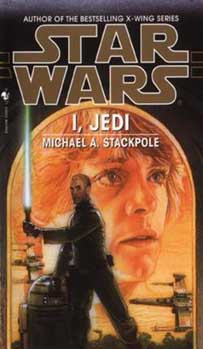In addition to being a flat-out fun read, “I, Jedi” (1998) accomplishes a lot: It’s the definitive character study of Corran Horn, showing how he finds balance among his various skills (investigator, pilot and Force-user), it elevates Kevin J. Anderson’s uneven “Jedi Academy Trilogy” by providing a new perspective, and it melds the “X-Wing Rogue Squadron” comics with the novels through the villain Leonia Tavira. “I, Jedi” ranks among my favorite “Star Wars” novels, and it’s my favorite of Michael Stackpole’s outstanding oeuvre.
Although there are other novels where we get into a character’s head (A.C. Crispin’s “Han Solo Trilogy” is the gold standard, along with Matthew Stover’s works), “I, Jedi” remains the only novel written in the first person. This approach is off-putting to some readers — and, indeed, it does take a couple chapters to get used to it — but it is the right choice for this book. I rooted for Corran every step of the way in his journey to rescue his kidnapped wife, Mirax. Building on the “X-Wing” novels, this book is the reason why Corran ranks as many fans’ No. 1 EU character. Sure, he has a tremendous skill set, but he’s generally humble and often finds himself faced with huge challenges, both tactical and personal; he’s an Everyman Superhero.
While Anderson’s “Jedi Academy Trilogy” isn’t awful, it is rather hokey, and Stackpole legitimizes it a lot by inserting Corran into the mix; he goes by the name Keiran Halcyon, and largely keeps to himself, thus explaining his lack of mention in Anderson’s novels (which I’ll have to reread soon to see how many liberties Stackpole took with the narrative). As he investigates Exar Kun’s murders on Yavin 4, Corran has various sounding boards — including fellow introvert Mara Jade — but it’s most enjoyable when he gets philosophical with Luke about the best way to train Jedi and what would be a just punishment for Kyp Durron, who murdered millions while under the influence of the Dark Side. (Like Stackpole, I was a bit bothered by Kyp’s rather abrupt shift from mass murderer to Jedi Knight in Anderson’s trilogy.)
In Act II, Corran sneaks onto his Imperial-sympathizing homeworld of Corellia and meets with his grandfather, who teaches him a lot about his Jedi heritage. And in the final segment, he goes undercover with the alias Jenos Idanian, infiltrating Tavira’s Invid pirates and putting together the information he needs to locate his wife. This final segment is most reminiscent of the “X-Wing” books in that we get dogfights, starfighter-HQ politics and a complex plot. While the dogfights are my least favorite things to read in Stackpole’s books, there are some nice twists here: Corran flies a TIE Defender, tries to convince his mates it’s best to use ion blasts rather than kill shots, and at one point (you had to know this was coming) faces Rogue Squadron.
Honestly, though, it’s the analytical conversations between Corran and his sounding-board-of-the-moment in the chapters after the fights that are the most enjoyable. In the final segment, we’re introduced to Elegos A’Kla and the Caamasi species, who have a cool trait: They remember big moments in life with crystal clarity and can transmit those memories to relatives or people with Force ability. We also meet the Jensaarai, a sect of basically good Jedi operating under the mistaken belief that the teachings of the Dark Side are correct and the Emperor was right to hunt down the Jedi. Although Elegos would play a role in future stories, the Jensaarai didn’t; perhaps their beliefs were tough to get a handle on.

(Surprisingly, Corran’s astromech droid, Whistler, never serves as a sounding board in “I, Jedi.” It’s understandable, though, due to the undercover nature of the mission.)
If I have one oh-so-slight complaint about “I, Jedi,” it’s that Corran segues pretty quickly into superhero territory in the final act. Throughout the book, he struggles to move objects with his mind — a flaw among all Jedi of the Halcyon line, we’re told — and yet he effectively projects images into people’s minds by the final act, creating a “Ghost Jedi” mythology that tricks everyone. We’re talking beyond-Luke-Skywalker-level powers here, and I can see why some readers would find this a bit convenient.
It’s also a shame that “I, Jedi” marked the end of in-depth explorations of Corran. Sure, we’ve been able to follow his story in the “New Jedi Order” era, including his fathering of two Force-sensitive children (Stackpole wrote two more novels after this one, early in the “NJO” series). But those books have so many characters that it’s impossible for a single one to capture a reader’s imagination the way Corran does in “I, Jedi.” Sadly, this type of in-depth character novel has largely been off Del Rey’s radar in the 15 years since “I, Jedi” was published. Let’s hope that John Jackson Miller’s recently released “Kenobi” will end the drought.

